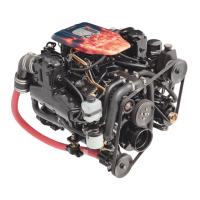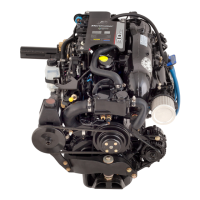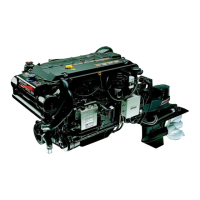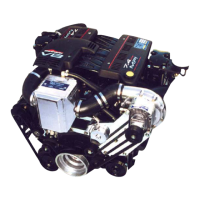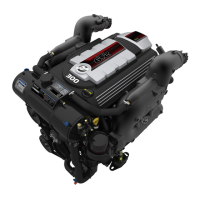Troubleshooting Shift Problems
If hard shifting, chucking, or racheting is encountered when shifting into forward gear, refer to the remote control manual or to
the appropriate sterndrive service manual for troubleshooting information.
PCM 112 Calibration Information
IMPORTANT: All of the following items are determined by the calibration of the PCM. Upgrading the calibration can result in
changes to these settings. For additional information refer to the PCM 112 Service Manual.
Default Sensor Values
Default sensor values are preprogrammed amounts used by the PCM to calculate fuel and ignition values, when the sensor in
question has exceeded its preprogrammed diagnostic limits. Default sensor values typically are used when the sensor has a
circuit high or circuit low fault.
Most temperature sensors default to 0° C (32° F). This can be verified by unplugging the sensor in question and watching the
data stream value with CDS G3.
Most pressure sensors also default to a preprogrammed number. MAP sensors, for example, usually default to 100 kPa
(29.5 in. Hg). The default value for a given pressure sensor can be verified by unplugging the sensor and watching the data
stream value.
Fault Conditions
Most faults can be detected either with the engine running or with the key on and the engine off. However, some faults can only
be detected with the engine running. Examples of such faults include all injector faults (fuel and direct).
In addition, some faults are programmed to ignore certain engine speeds. For example, the low block pressure sensor fault
(sea pump pressure on a MerCruiser) is typically not enabled until enough RPM has been achieved to develop a reasonable
amount of water pressure. Therefore, this fault will not be set at idle.
Faults also take a certain time to set. The time it takes to set a fault varies greatly and can also vary with engine RPM. Faults
generally set faster at higher engine speeds.
Sticky and Nonsticky Faults
All faults are classified as either sticky or nonsticky. Sticky means that the fault, once set, will continue to show up as active,
even if the circuit or problem has corrected itself. A key switch cycle is required to reset a sticky fault.
A nonsticky fault is a fault that will change its status from active to inactive without requiring a key switch cycle.
CDS G3 will continue to display a sticky fault as active, even though the cause of the fault has been corrected. Cycle the key to
reset all faults if there is difficulty correcting a fault.
OBD‑M Faults
There are two classes of OBD‑M faults, corresponding with the severity of the fault. An OBD‑M 1 fault is one that requires
immediate action, such as a TPS fault. An OBD‑M 2 fault is one that will not endanger the engine or the occupant. OBD‑M 2
faults are only set after a second occurrence and are used primarily for emissions control components.
OBD‑M faults can be cleared with CDS G3. Refer to the PCM 112 Service Manual for further information on OBD‑M faults.
CDS G3 Service Tool
Introduction
G3 is a standalone program that provides diagnostic support for select engines and Mercury joystick piloting systems.
Additionally, all configuration functions necessary for preparing these systems for delivery are also supported. G3 allows for
CAN‑based multiple‑processor communication through a clean, easy‑to‑navigate interface.
This manual assumes that you have successfully installed G3 on your computer and have updated it to the most current
version. For installation instructions, refer to the user manual loaded onto the computer diagnostic system laptop (in the
Windows® Start menu > All Programs > Mercury Marine > User Manual) or on the G3 software installation disc.
Connecting and Starting G3
Connection to the Engine
1. Insert the G3 SmartCraft diagnostic interface USB connector into a powered USB port on your computer.
2. Connect the SmartCraft diagnostic interface 9‑pin connector to the CAN P/CAN H adapter harness 9‑pin connector.
3. Connect the CAN P/CAN H adapter harness to the G3 engine harness adapter.
4. Remove the CAN P/CAN H termination resistor from the engine harness.
5. Connect the G3 engine harness adapter to the CAN P/CAN H engine harness connector.
Troubleshooting
Page 1D-22 © 2016 Mercury Marine 90-8M0099748 eng DECEMBER 2015
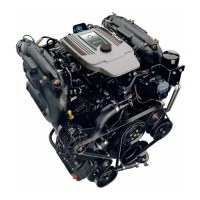
